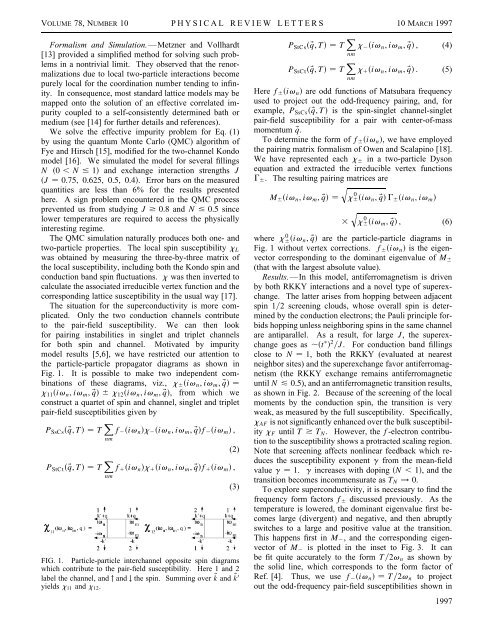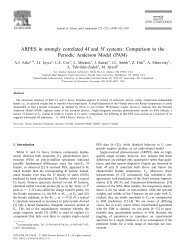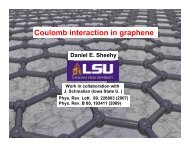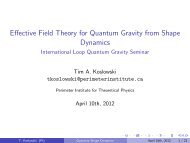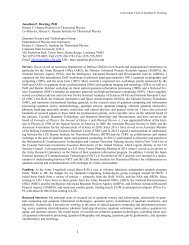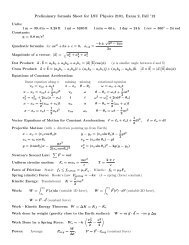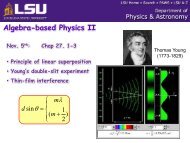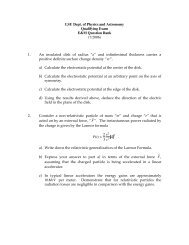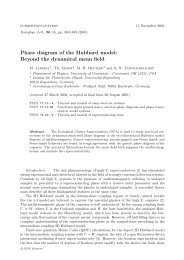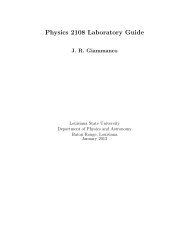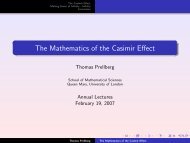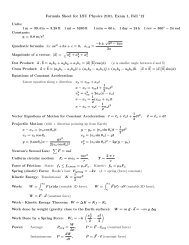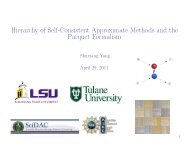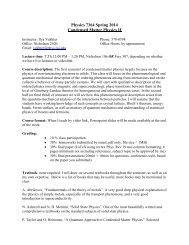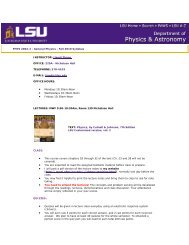Phase Diagram of the Two-Channel Kondo Lattice - APS Link ...
Phase Diagram of the Two-Channel Kondo Lattice - APS Link ...
Phase Diagram of the Two-Channel Kondo Lattice - APS Link ...
Create successful ePaper yourself
Turn your PDF publications into a flip-book with our unique Google optimized e-Paper software.
VOLUME 78, NUMBER 10 PHYSICAL REVIEW LETTERS 10MARCH 1997<br />
Formalism and Simulation.—Metzner and Vollhardt<br />
[13] provided a simplified method for solving such problems<br />
in a nontrivial limit. They observed that <strong>the</strong> renormalizations<br />
due to local two-particle interactions become<br />
purely local for <strong>the</strong> coordination number tending to infinity.<br />
In consequence, most standard lattice models may be<br />
mapped onto <strong>the</strong> solution <strong>of</strong> an effective correlated impurity<br />
coupled to a self-consistently determined bath or<br />
medium (see [14] for fur<strong>the</strong>r details and references).<br />
We solve <strong>the</strong> effective impurity problem for Eq. (1)<br />
by using <strong>the</strong> quantum Monte Carlo (QMC) algorithm <strong>of</strong><br />
Fye and Hirsch [15], modified for <strong>the</strong> two-channel <strong>Kondo</strong><br />
model [16]. We simulated <strong>the</strong> model for several fillings<br />
N 0 , N # 1 and exchange interaction strengths J<br />
J 0.75, 0.625, 0.5, 0.4. Error bars on <strong>the</strong> measured<br />
quantities are less than 6% for <strong>the</strong> results presented<br />
here. A sign problem encountered in <strong>the</strong> QMC process<br />
prevented us from studying J $ 0.8 and N # 0.5 since<br />
lower temperatures are required to access <strong>the</strong> physically<br />
interesting regime.<br />
The QMC simulation naturally produces both one- and<br />
two-particle properties. The local spin susceptibility x L<br />
was obtained by measuring <strong>the</strong> three-by-three matrix <strong>of</strong><br />
<strong>the</strong> local susceptibility, including both <strong>the</strong> <strong>Kondo</strong> spin and<br />
conduction band spin fluctuations. x was <strong>the</strong>n inverted to<br />
calculate <strong>the</strong> associated irreducible vertex function and <strong>the</strong><br />
corresponding lattice susceptibility in <strong>the</strong> usual way [17].<br />
The situation for <strong>the</strong> superconductivity is more complicated.<br />
Only <strong>the</strong> two conduction channels contribute<br />
to <strong>the</strong> pair-field susceptibility. We can <strong>the</strong>n look<br />
for pairing instabilities in singlet and triplet channels<br />
for both spin and channel. Motivated by impurity<br />
model results [5,6], we have restricted our attention to<br />
<strong>the</strong> particle-particle propagator diagrams as shown in<br />
Fig. 1. It is possible to make two independent combinations<br />
<strong>of</strong> <strong>the</strong>se diagrams, viz., x 6 iv n , iv m , q <br />
x 11 iv n , iv m , q 6x 12 iv n , iv m , q, from which we<br />
construct a quartet <strong>of</strong> spin and channel, singlet and triplet<br />
pair-field susceptibilities given by<br />
P SsCs q, T T X nm<br />
f 2 iv n x 2 iv n , iv m , qf 2 iv m ,<br />
(2)<br />
P StCt q, T T X f 1 iv n x 1 iv n , iv m , qf 1 iv m ,<br />
nm<br />
(3)<br />
FIG. 1. Particle-particle interchannel opposite spin diagrams<br />
which contribute to <strong>the</strong> pair-field susceptibility. Here 1 and 2<br />
label <strong>the</strong> channel, and " and # <strong>the</strong> spin. Summing over k and k 0<br />
yields x 11 and x 12 .<br />
P StCs q, T T X nm<br />
x 2 iv n , iv m , q , (4)<br />
P SsCt q, T T X nm<br />
x 1 iv n , iv m , q . (5)<br />
Here f 6 iv n are odd functions <strong>of</strong> Matsubara frequency<br />
used to project out <strong>the</strong> odd-frequency pairing, and, for<br />
example, P SsCs q, T is <strong>the</strong> spin-singlet channel-singlet<br />
pair-field susceptibility for a pair with center-<strong>of</strong>-mass<br />
momentum q.<br />
To determine <strong>the</strong> form <strong>of</strong> f 6 iv n , we have employed<br />
<strong>the</strong> pairing matrix formalism <strong>of</strong> Owen and Scalapino [18].<br />
We have represented each x 6 in a two-particle Dyson<br />
equation and extracted <strong>the</strong> irreducible vertex functions<br />
G 6 . The resulting pairing matrices are<br />
q<br />
M 6 iv n , iv m , q x6iv 0 n , q G 6 iv n , iv m <br />
3<br />
q<br />
x 0 6iv m , q , (6)<br />
where x6 0 iv n, q are <strong>the</strong> particle-particle diagrams in<br />
Fig. 1 without vertex corrections. f 6 iv n is <strong>the</strong> eigenvector<br />
corresponding to <strong>the</strong> dominant eigenvalue <strong>of</strong> M 6<br />
(that with <strong>the</strong> largest absolute value).<br />
Results.—In this model, antiferromagnetism is driven<br />
by both RKKY interactions and a novel type <strong>of</strong> superexchange.<br />
The latter arises from hopping between adjacent<br />
spin 12 screening clouds, whose overall spin is determined<br />
by <strong>the</strong> conduction electrons; <strong>the</strong> Pauli principle forbids<br />
hopping unless neighboring spins in <strong>the</strong> same channel<br />
are antiparallel. As a result, for large J, <strong>the</strong> superexchange<br />
goes as t 2 J. For conduction band fillings<br />
close to N 1, both <strong>the</strong> RKKY (evaluated at nearest<br />
neighbor sites) and <strong>the</strong> superexchange favor antiferromagnetism<br />
(<strong>the</strong> RKKY exchange remains antiferromagnetic<br />
until N & 0.5), and an antiferromagnetic transition results,<br />
as shown in Fig. 2. Because <strong>of</strong> <strong>the</strong> screening <strong>of</strong> <strong>the</strong> local<br />
moments by <strong>the</strong> conduction spin, <strong>the</strong> transition is very<br />
weak, as measured by <strong>the</strong> full susceptibility. Specifically,<br />
x AF is not significantly enhanced over <strong>the</strong> bulk susceptibility<br />
x F until T * T N . However, <strong>the</strong> f-electron contribution<br />
to <strong>the</strong> susceptibility shows a protracted scaling region.<br />
Note that screening affects nonlinear feedback which reduces<br />
<strong>the</strong> susceptibility exponent g from <strong>the</strong> mean-field<br />
value g 1. g increases with doping N , 1, and <strong>the</strong><br />
transition becomes incommensurate as T N ! 0.<br />
To explore superconductivity, it is necessary to find <strong>the</strong><br />
frequency form factors f 6 discussed previously. As <strong>the</strong><br />
temperature is lowered, <strong>the</strong> dominant eigenvalue first becomes<br />
large (divergent) and negative, and <strong>the</strong>n abruptly<br />
switches to a large and positive value at <strong>the</strong> transition.<br />
This happens first in M 2 , and <strong>the</strong> corresponding eigenvector<br />
<strong>of</strong> M 2 is plotted in <strong>the</strong> inset to Fig. 3. It can<br />
be fit quite accurately to <strong>the</strong> form T2v n as shown by<br />
<strong>the</strong> solid line, which corresponds to <strong>the</strong> form factor <strong>of</strong><br />
Ref. [4]. Thus, we use f 2 iv n T2v n to project<br />
out <strong>the</strong> odd-frequency pair-field susceptibilities shown in<br />
1997


